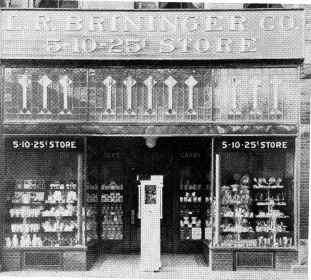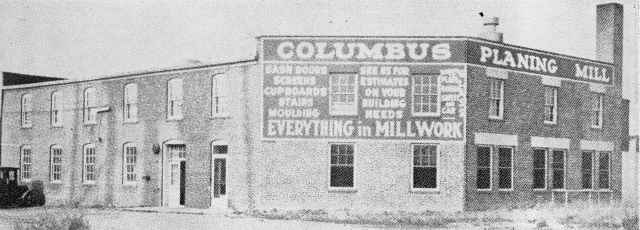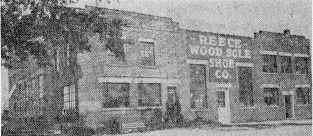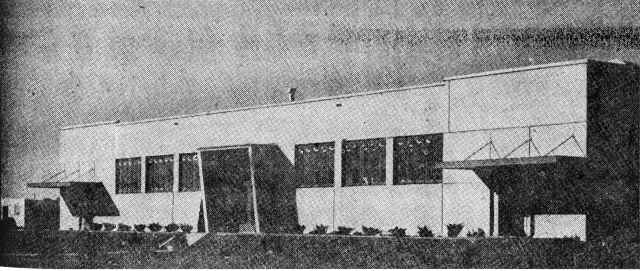
The L. R. Brininger Company, 1926.
NEGenWeb Project
Resource Center
On-Line Library
The L. R. Brininger Company, 1926. |
in Columbus, providing for a monthly rental of two hundred thirty dollars the first five years, automatically increasing with each five year period. At that time L. R. Brininger bought the M. Brugger Building, previously occupied by Martin Speicher and Son. The price paid was twenty-five thousand dollars. He also leased the next building to the west, which at that time belonged to the Politis Estate. These two buildings are now known as the Scott Building and Woolworth's store occupy the former State Bank Building at Thirteenth Street and Twenty-sixth Avenue.
The last mule-drawn delivery system in the city was replaced by motor trucks in January, 1925. Founded by Mark Rathburn in 1910, the mule-drawn system was later sold to Edward Webb and then to John R. Luschen. The latter used the system exclusively for his grocery deliveries. At the time motor transportation was instituted, Luschen owned three teams of mules and one horse. The latter animal had a history which paralleled that of Columbus in its transition from pioneer verve to mundane utility. Formerly the race horse belonging to Barney McTaggert, it had left the excited throngs of track fans to settle into a delivery wagon harness.
The new-found business and industrial strength of Columbus may be gauged by the year 1947 when bank credits climbed more than one million dollars and reached $9,481,730.34 in December. Included among the exhibitors at the Columbus manufacturers' show the following January, were (in addition to those already mentioned in this chapter): the Lund Planing Mill, lumber material; the Al-Fa-Meal Company, dehydrated alfalfa; Glur Cement Works, cement blocks; Egger Cement Contractors, cement blocks; Cook Manufacturing Company, farm equipment; Loup River Public Power District, electricity; Columbus Grain Company, processed grain.
Not all of the business activity of the region is in manufacture. The Nebraska Continental Telephone Company has its headquarters in Columbus and the M. M. Van Berg Livestock Sales Pavilion on the southwest side of town schedules regular sales which begin early in the afternoon and frequently last until midnight. From all over the county, farmers and livestock raisers attend this auction in the specially constructed pavilion which holds one thousand people.
The shift in the type of economy of the region which saw a surplus of farm goods raised in Platte County was responsible for one of the earliest industrial developments -- grain elevators and mills. In the beginning the first settlers had raised just enough sod corn and garden vegetables to maintain their own families, adding to their diet with supplies of wild fruit, fresh game and fish. There was no surplus to market.
Soon small gristmills began to appear and it was not many years until the soil having been cultivated and acreage extended through claims and purchase, the pioneers discovered that they could export as well as import. The advent of the railroad had opened the way to the rest of the consuming world and the storage and processing of grain was a natural first step.
In 1859, when James Galley, Sr. moved his family to Platte County, it was necessary to go to Fort Calhoun or to Milford to have grist ground. Often, after reaching the mill, his son J. H. Galley would have to go into the woods and gather wood to be used as fuel in operating it. Seven years later the first Columbus elevator, originally a steam mill, was built by Francis A, Hoffman with a capacity of fifteen thousand bushels; this was followed by the Union Pacific Elevator in 1869 and Becker's Elevator in 1875.
The pioneer partners, Jaeggi and Schupbach, were original builders of the present Columbus Milling Company, then known as the Elevator Roller Mills. Flour from this mill was sold to Chicago. During peak seasons the mill doubled its output of one hundred barrels of flour per day by running a night shift. This outlet was an important one for Platte County farmers who thereby were afforded an opportunity of mak-
| Industry | 391 |
ing Columbus their selling, as well as their buying center.
The day has passed for the business of stock buyers. For a livestock market, the majority of stock raisers today truck their animals into Omaha where huge stockyard facilities are available. Dairy products, turkey and other fowl are sold to Swift & Company headquarters in Columbus and on Omaha markets.
Business as well as industry has developed with the community, focusing on the needs of a part of the country which takes its economic cue from the soil. Well-boring equipment was one of the first demands to be supplied by the Columbus Foundry Company, established in 1875 by Charles Schroeder, and later owned by Charles and G. W. Schroeder. This firm also made wind mills on order and added to the foundry business a good trade in wagons and buggies.
The Columbus Flax and Fiber Company was another early concern drawing upon the natural resources of the region. Another was a planing mill, capable of manufacturing sash and door materials and the much-in-demand, 19th century "scroll sawing" used so extensively in building of that era.
Lumber and brick companies followed in the roll call of Columbus' business development (in 1878 a local mason predicted that the following year, bricks would sell in Platte County for five dollars per thousand), and a granite and marble works, organized in 1905, further enhanced the possibilities of a building industry in the region.
In the early 1900's a brickyard was operated by Karr & Nichols at Twelfth Street and Twelfth Avenue, later Julius Nichols became the owner and operated it until 1940.
Typifying the progressive merchants of the community was the firm of Boyd and Ragatz, hardware dealers, who started in business in Columbus in 1909, saw the transition from heating stoves to gas, coal and oil and finally automatically controlled furnaces. The firm has belonged to the D.D.D. Boyd's since 1920.
Indicative of the modern trend toward power-operated farms was the incorporation,

The M. H. Van Berg Soles Pavilion, completed in 1936

The Columbus Planing Mill, at the corner of Eleventh Street and Twenty-eighth Avenue.
| 392 | The History of Platte County Nebraska |
in 1923, of the Haverland Manufacturing Company for the purpose of "manufacturing, designing and installing machines and equipment relating to mechanical, electrical, chemical, hydraulic, aeronautical or pneumatic engineering." And Columbus stepped up its output and added to its stature as an industrial community when American Carbide and Chemical Corporation opened for business in 1938.
One day two men, the Agenstein brothers of Darlington, Wisconsin, happened to stop in Columbus on their way back to their home state from Idaho. They studied the town carefully, analyzed the dairy country surrounding it, and decided to return and build a cheese factory here. This was in 1925, the same year that the Columbus Canning Factory reopened with a plant capacity of thirty thousand cans per day. Operating the cannery was Miss La-Blanche Farmer, daughter of an Iowa cannery owner, who had managed her first food processing firm at the age of seventeen.
The Beatrice Cream Company and Martyn Wholesale Bakery also entered the key Platte County community about that time and retail establishments of every type grew up in tempo with the area's rapidly expanding influence as an agricultural supply center. In spite of its manufacturing activities, Columbus has drawn a relatively small percentage of organized labor, since most of the employment needs of the Platte and Loup plants are supplied by the local population and by far the largest share of business initiative and capital has been that of Columbus residents. In recent years, several chain operations have moved into the community from "outside" and to meet the competition, many local retailers have found themselves developing chain enterprises of their own.
Not all of Columbus' enterprising young businessmen have achieved their success on a local basis. A former Platte County attorney, Marvin G. Schmid, went into partnership with Taylor H. Snow and Adrian L. Faasse in Omaha with capital loaned them by Elmer Bradley, Columbus banker. The trio, all former Army officers, established the Snow Corporation in 1946, after all had been discharged from the service. They now manufacture tractor umbrellas and grain loaders. Another concern has been set up by the same men to act as a distributing agency.
Today, the Columbus Business Directory lists such diverse operations as airports, auctioneers, building and loan associations, cemeteries, credit bureaus and coal-yards. As a result of the giant power projects with headquarters in the city, a firm of public utility engineers and analysts is now located in what was once a quiet agricultural community. Livestock, nurseries, produce, and transportation are well represented and extensive real estate dealings, are carried on by a half dozen firms, including the pioneer companies of Becher, Hockenberger & Chambers, and the Speice, Echols, Boettcher Company.
Building permits
have reached a new high, and expansion and remodeling is the next move on
the part of Columbus' improvement-minded business leaders -- men and women,
of all nationalities, origins, and many and diverse backgrounds. Truly, as
was written in 1875, the county has been found to possess "exhaustless
agricultural and pastoral resources . . . " and gone ahead to turn the
pioneers' dream into a reality, the dream of "various and extensive
manufactures" for the richly productive valleys of the Loup and Platte.
| Industry | 393 |

Behlen Manufacturing Company.

Reece Wood Sale Shoe Company factory.

Full view of Becton, Dickinson and Company plant.

Becton, Dickinson and Company, a medical supply company, manufacturers of B-D Products, opened November 22, 1949.
| © 2005 for the NEGenWeb Project by Ted & Carole Miller |
|||